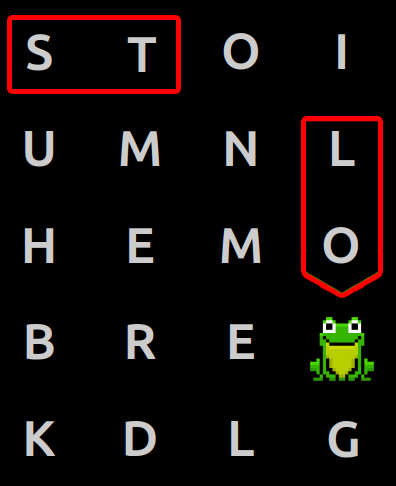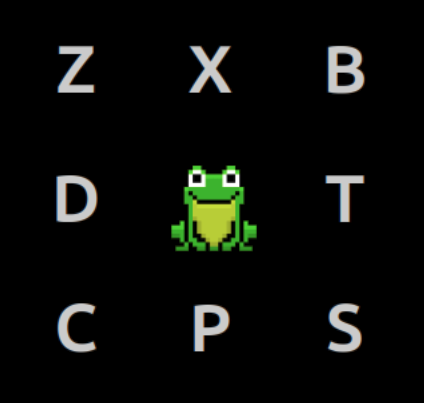With Patent Pending Pizzazz
How To Play
Find all of the words by tapping on (or clicking on) each of the letters that make the words. Scroll to access the entire puzzle.
It is possible for the spelling of a word to be scattered throughout the puzzle. For example, if "LOST" is one of the words, "LO" may be in one area of the puzzle, and its "ST" part may be in some other area of the puzzle.

Frogs enable a word to be separated as shown in the preceding image. The "O" cell in "LOST" touches a frog cell, which allows the word "LOST" to be split at (i.e., jump from) the "O" cell.

A frog cell, touching any side or any corner of a letter cell associated with a word, optionally enables the spelling of the word to resume elsewhere in the puzzle. A frog cell need not touch the cell where the word resumes.
Hence, the spelling of a word can jump to somewhere else in the puzzle if a frog is encountered. The spelling of a word can jump multiple times.
Be careful — some frogs are decoys, and some letter sequences are decoys!
When you want to check your progress tap (or click) the "Check Answer" button. A cell that changes color to green (when the "Check Answer" button is tapped or clicked) means that letter is part of the answer.
To be declared a winner; all words must be found and, all wrong letters must be removed from your selections.
This proof-of-concept demonstration exhibits only one of the multiple patent pending puzzle features that are coming.
The Eon Puzzle Story
Some time ago I was helping in a first through third grade Sunday School class. The teacher — Mrs. Rosemary — would occasionally give the students a word seek puzzle to supplement the lesson.
One day during class; having just completed the word seek puzzle for that lesson, one student declared “These are too easy for me!” They were. The student — a vivacious little guy named Preston — had been completing the puzzles in roughly half the time compared to the other students (and Preston was not the oldest student).
Later, in the same week of Preston’s declaration, a homemade word search puzzle was produced for the class. This puzzle was designed to be a tiny bit more challenging, and decidedly more fun. The words to be sought were taken from the text to be studied the upcoming Sunday. It worked. Neither Preston nor the other students finished that puzzle quite so quickly.
Eon Puzzle — its patent pending features (only one being shown here) — are an indirect result of that homemade endeavor.
